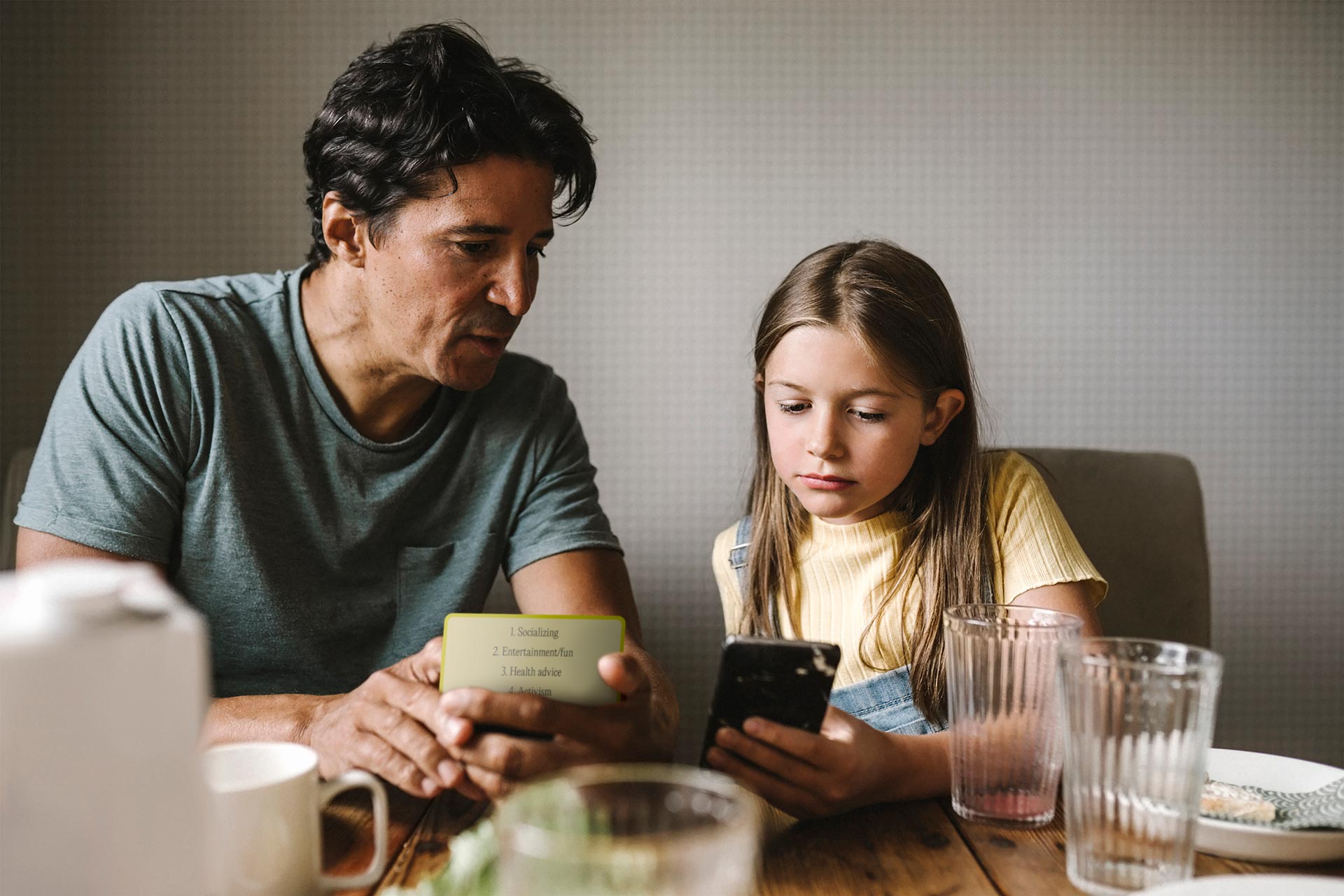Parents everywhere are noticing the same quiet struggle kids scrolling endlessly through videos, games, and feeds that never seem to end. What begins as a harmless distraction can quickly turn into a routine that feels impossible to break. A few minutes of screen time after school easily stretches into hours, leaving children restless, overstimulated, and reluctant to disconnect. The design behind these platforms isn’t accidental; every swipe is crafted to hold attention, creating a subtle loop that keeps young minds craving the next image, sound, or reaction.
This challenge isn’t about blaming technology or labeling our children as addicted. It’s about understanding how the science of reward, attention, and curiosity works in growing brains and how those same systems are gently manipulated by modern media. When parents recognize why kids can’t stop scrolling, they can respond not with frustration but with empathy. From that awareness comes the power to guide children toward balance, helping them rediscover calm, focus, and genuine connection in the world beyond the screen.

Key takeaways:
- Infinite scrolling triggers dopamine-driven reward loops that reinforce compulsive behavior and weaken children’s attention regulation.
- Prolonged screen exposure alters neural pathways controlling impulse regulation and emotional stability in developing brains.
- Collaborative family routines and shared digital boundaries rebuild self-regulation and reduce dependency on constant digital stimulation.
- Empathetic, neuroscience-informed parenting transforms screen management into relational guidance, fostering resilience and emotional growth.
The psychology behind scrolling addiction
How the reward loop works
When a child scrolls through short videos or posts, their brain enters a rapid cycle of anticipation and reward. Each swipe brings the chance of seeing something funny, surprising, or satisfying, and that unpredictability is what keeps them hooked. Scientists refer to this as variable reward reinforcement, a process that trains the brain to repeat actions that deliver unpredictable rewards.
This reward loop becomes particularly powerful in children because their brains are still developing key self-control systems. The prefrontal cortex, the part that helps manage decision-making and resist impulses, matures slowly, while the emotional and reward centers are already highly active. This developmental gap creates a perfect storm for compulsive scrolling.
You can think of this process in three parts:
- Trigger: A notification, sound, or curiosity prompt starts the urge to check the screen.
- Action: The child scrolls or taps, seeking something new or exciting.
- Reward: A funny video, a like, or a comment delivers a burst of dopamine, the brain’s “feel-good” chemical.
Each loop strengthens the habit. Over time:
- The brain learns that scrolling equals pleasure, even if the content isn’t meaningful.
- Anticipation becomes addictive, as the next scroll might feel even better.
- Children begin to find it harder to delay gratification, preferring quick hits of excitement over slower, real-world rewards.
Parents often recognize this pattern when their child says, “Just five more minutes,” and those minutes quietly stretch into an hour. What looks like simple screen use is actually the brain chasing that next unpredictable reward, a loop that’s hard to break without awareness and guidance.
Why the brain struggles to stop
Scrolling feels effortless, but what happens underneath is complex. With every new image or clip, the brain releases dopamine, a chemical tied to pleasure and motivation. The more unpredictable the content, the stronger the dopamine response. Over time, the brain learns to crave that next small hit of excitement.
Neuroscience research shared through the National Institutes of Health (NIH) highlights that extended digital stimulation can alter the brain’s reward circuits, affecting areas that control attention and impulse regulation. These findings help explain why some children become restless or moody after screen use: their brains are adjusting to a constant flood of reward signals that real life can’t always match.
- Predictable satisfaction (reading, playing, building) develops patience.
- Unpredictable rewards (scrolling, gaming, notifications) condition craving.
- Balanced experiences build resilience and self-awareness.
The emotional side of scrolling
Scrolling doesn’t just entertain children; it often meets deeper emotional needs. When a child feels lonely, bored, or anxious, a device becomes an easy form of comfort and distraction. It fills silence, smooths discomfort, and temporarily calms uneasy feelings. But the relief is short-lived, and when the screen goes dark, the same emotions quietly return.
You can think of this as an emotional regulation loop:
- Trigger: A difficult feeling appears, such as boredom, sadness, or stress.
- Escape: The child turns to the screen for distraction or comfort.
- Relief: The content delivers a momentary lift or sense of connection.
- Return: The relief fades, leaving the same feeling underneath, often stronger than before.
This pattern doesn’t mean a child is “addicted” in a moral or behavioral sense. Instead, they are trying to regulate emotions in the only way that currently feels safe or accessible.
As parents, our role isn’t to remove that coping tool with frustration or punishment but to guide them gently toward balance by:
- Offering emotional presence when they feel uneasy or overstimulated.
- Encouraging healthy self-soothing alternatives like drawing, movement, or music.
- Modeling calm responses to stress and technology ourselves.
When children feel understood, not judged, they become more willing to talk about their habits and less likely to hide them. Compassion, not control, is what opens the door to lasting change.
The hidden effects of infinite scrolling on children
The emotional impact

The endless scroll quietly reshapes how children see themselves and the world around them. As their feeds fill with pictures of perfect lives, friends who always seem happier, families who appear closer, influencers who never seem tired, children may start comparing their everyday moments to those highlights. That comparison slowly chips away at self-confidence, replacing curiosity and joy with uncertainty and self-doubt.
Parents often notice the changes gently unfolding:
- The child who once laughed freely now worries about being judged or left out.
- Conversations start centering on appearance, popularity, or digital approval.
- Joyful spontaneity fades, replaced by quiet self-criticism.
The emotional effects of scrolling are not only about what children see but also how they experience it. The rapid rhythm of endless content trains the brain to expect instant feedback and constant stimulation.
Over time, this can create subtle but powerful emotional shifts:
- Impatience with real life: Moments without stimulation start to feel uncomfortable.
- Low tolerance for stillness: Tasks that require focus or waiting seem dull or frustrating.
- Reduced motivation: Real-world rewards, which take longer to achieve, lose their appeal compared to quick online gratification.
These patterns often appear slowly, which is why compassionate awareness matters more than correction. When parents notice and name these feelings without judgment, children begin to feel seen rather than blamed important first step toward balance.
The cognitive and relational cost
Children’s minds need space to wander, reflect, and rest. Continuous scrolling compresses those spaces, keeping the brain in a constant state of light engagement rather than deep thought. Over time, this pattern begins to reshape how they learn, remember, and solve problems.
The cognitive effects can include:
- Shallow attention: The brain stays alert but never settles long enough to build deep understanding.
- Weakened memory: Constant novelty interrupts the mental rest needed for information to take hold.
- Reduced creativity: When imagination is replaced by passive consumption, curiosity begins to fade.
The consequences extend beyond thinking the connection. Even while sitting beside loved ones, a child absorbed in a screen can feel mentally elsewhere. Parents sense it in subtle ways:
- Conversations feel one-sided or short.
- Shared activities lose their spark.
- Eye contact becomes rare, replaced by a distant focus on the device.
Reducing scrolling gradually brings back what every family craves presence. That simple, quiet awareness makes room for laughter, empathy, and cooperation to return.
When families approach this topic with patience and trust, rather than rigid control, conversations about screen time for kids often feel calmer and more collaborative. Children start to sense that balance isn’t about punishment but partnership.
How much scrolling is too much?
Recognizing when use becomes unhealthy
There is no universal rule for how long children should spend scrolling. What matters more is the effect on their emotions, routines, and relationships.
Parents can watch for gentle signals:
- Scrolling stretches late into the night, interrupting sleep.
- Devices replace play, reading, or outdoor time.
- Mood changes appear when screens are limited.
- Family meals or conversations feel distracted or tense.
When these patterns persist, the issue is less about duration and more about dependency. Recent behavioral studies published by ScienceDirect describe how prolonged screen exposure, especially over four hours a day, correlates with increased anxiety, sleep loss, and lower self-esteem in children.
|
Pattern |
Balanced Use |
Unhealthy Use |
|
Purpose |
Learning or connection |
Escaping boredom or stress |
|
Emotion after use |
Calm or inspired |
Irritable or restless |
|
Transition |
Easy to stop |
Feels “stuck” or resistant |
|
Effect on life |
Supports growth and rest |
Disrupts sleep and relationships |
Healthy scrolling feels flexible and conscious. Unhealthy scrolling feels urgent and automatic. Recognizing the difference allows families to make gentle changes before habits harden.
Small routines that include rest, movement, and mindful device use can help restore family rhythm and emotional steadiness, a reminder that balancing screen health starts with gentle consistency, not strict limits.
How to break the dopamine reward loop (step-by-step)
Start with connection, not control
The first step is empathy. Instead of beginning with limits, start with curiosity. Ask your child when scrolling feels hardest to stop and what makes it comforting. This helps them feel understood and involved. When children see that the goal is not punishment but partnership, they become more open to change.
Model the behavior you hope to see
Children learn more from what we practice than what we preach. Setting phones aside during family time communicates value without words. Admitting our own struggles “It’s hard for me to put my phone down too” builds honesty and shows that self-control is a shared challenge, not a one-sided rule.
Make subtle environmental changes
Small adjustments can shift habits without confrontation:
- Turn off autoplay and push alerts that invite endless scrolling.
- Keep devices charging in common areas instead of bedrooms.
- Set natural pauses before and after screen sessions to reset the mind.
- Switch screens to grayscale to reduce visual stimulation.
Each change creates space for awareness of the moment needed to make a conscious choice instead of a reflexive one.
Replace scrolling with living rewards
The goal is not to remove pleasure but to relocate it. Encourage activities that stimulate the same reward circuits through creativity, movement, and connection.
- Invite your child to cook, draw, or garden with you.
- Spend time outdoors where their senses engage naturally.
- Reintroduce quiet family rituals, storytelling, reading, shared meals that anchor attention and calm.
These experiences rebuild slower, steadier dopamine pathways that restore joy and presence.
Co-create a family digital agreement
Rules imposed by parents often lead to resistance, but agreements created together nurture cooperation. Sit down as a family and decide when, where, and how devices fit into your daily rhythm. Let your child contribute ideas about what feels fair and helpful. Revisiting this conversation regularly keeps it collaborative and relevant.
Respond with understanding when things slip
Habits take time to reshape. When old patterns return, avoid shaming or scolding. Instead, approach with empathy: “It looks like scrolling is hard to stop today. What might help next time?” Compassion keeps communication open and strengthens trust.
When the behavior begins affecting mood, sleep, or school, professional support from a counselor familiar with screen-related challenges can provide extra guidance and reassurance.
Rebuilding reward pathways
As children regain balance, they need to rediscover the rewards of real life. Simple experiences finishing a puzzle, baking together, helping a friend create a different kind of satisfaction. These activities produce smaller but steadier waves of dopamine, reminding the brain that pleasure can come from patience and participation.
Moments of boredom also deserve to be welcomed back. When children learn to sit in quiet or daydream without reaching for a device, creativity and emotional strength grow. Over time, they begin to fill those once-digital moments with imagination and real connection.
The ongoing relationship between curiosity, focus, and emotional growth shows how child development and tech balance depend on daily habits that nurture both exploration and rest.
Finding balance together

Helping children break the reward loop is not about rigid limits but gentle guidance. It means recognizing that scrolling offers something emotional, a sense of escape, comfort, or control, and meeting those needs through connection instead.
When families model awareness, set shared intentions, and stay patient through setbacks, children gradually learn to self-regulate. They begin to discover that the deepest rewards are not on a screen at all but in the laughter, creativity, and closeness that real life brings. Families who continue to grow in this awareness often find reassurance through Raising Digital Citizens, where the focus remains on connection, collaboration, and respect for every child’s pace.





